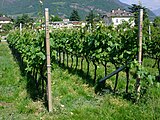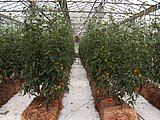Hectare effort
The hectare expenditure , given in kg / ha or l / ha , is the amount of a plant protection product which is intended to protect the cultivated plants against disease and pest infestation or to prevent undesirable development of weeds or weeds . The hectare - the reference here is the area - is the current specification of the required amount of pesticides to protect an agricultural crop. The "concentration information in percent of the spray liquid", which was used from the beginning of plant protection with plant protection products, is only used in certain cases, namely if this is required by the effective proportion of the plant protection product, for example in the case of plant protection oils during spraying.
The specification of a hectare expenditure for a spatial culture brings with it problems, so that a changeover to the specification in kg or l of leaf wall area takes place.
Area and spatial cultures
Agricultural areas such as grain , are area crops . Here, the hectare effort is applied to the flat area (corresponds to the base area) with suitable equipment. Wine and orchards , on the other hand, are spatial cultures . Here, the distribution of the hectare application rate causes problems in that the leaf wall area to be treated varies in size over the course of the year.
Hectares for spatial crops - vineyards and orchards
According to the application regulations, increasing application rates / ha are permitted or specified according to the respective BBCH scale for grapevines . This means that the active ingredient content per unit of leaf area remains roughly the same. According to the registration regulations, the hectares are maximum hectares for a certain BBCH scale for grapevines and must not be exceeded at this stage. The hectare application rate is applied with the amount of water (usually 400–800 l water / ha) of the selected application method (application method), regardless of the resulting concentration. The amount of active ingredient per leaf area and not the concentration of the spray liquid (with the exception of some preparations) is decisive for effectiveness.
Expenditure per hectare in Austria
Today the majority of registered pesticides contain a hectare application in kg or l / ha. In addition, the maximum permissible application rates are given for grapevines depending on the BBCH scale.
| BBCH scale for grapevines | Application rate kg or l / ha |
|---|---|
| from stage 15 (5 leaves unfolded) to stage 61 (start of flowering) | 0.47-1.25 |
| up to stage 71 (fruit set) | 0.78-1.88 |
| from stage 71 (fruit set) | 1.25-2.5 |
The hectare expenditure (calculation basis 1000 liters of water / ha) is designed for the row distances of 2.8–3.3 m, which are mainly common in Austria . With closer row spacing of 2–2.5 m row spacing, the leaf wall area to be protected increases (including the leaf surface). Therefore, the hectare expenditure must be increased accordingly. According to the approval regulations, however, this is not possible, as the maximum hectare must not be exceeded. The hectare expenditure results from the risk assessment in the approval process and applies as the upper limit in all assessment steps.
Hectare effort data in Germany
Since the 1980s, the application rate for pesticides in viticulture has been given in kg / ha of base area. In Germany , a basic effort (kg / ha) is set with the approval, which is then increased via a scaling factor (1 to 4) depending on the stage. The aim is to adapt the ha application rate to the population growth. The basis for the calculation is the basic effort (kg or l / ha), which is usually related to the first pre-flowering treatment. This is adapted in the course of the vegetation period to the stage of development of the vine and the associated enlargement of the target area. The basic effort is multiplied by a factor between 1.5 and 4, depending on the stage of development. The calculated amounts are stirred into the amount of water to be applied and then applied. The values given in the table refer to normal plants of medium growth with a row spacing of approx. 1.6 to 2.0 m. In the case of significantly wider row spacings, proportional deductions can be made to these values.
| BBCH scale for grapevines | 00 - 09 | 11-16 | 17-61 | 68-69 | 71 | 73-75 | 75-81 |
|---|---|---|---|---|---|---|---|
| Treatment appointments | Winter / budding | 1. Pre-flowering | from 2nd pre-flowering | outgoing bloom | 2. Post-bloom | from the 3rd second flowering, depending on the density of the foliage wall | |
|
Basic effort (kg or l / ha) |
x 1 | x 1 | x 1.5 to 2 | x 2.5 | x 3 | x 3.5 to 4 | x 4 |
| recommended water consumption (l / ha) | 100 - 400 | 100 - 400 | 200 - 800 | 250-800 | 300-800 | 400-800 | 400-800 |
Problem
It turns out that the specification as hectare expenditure from the point of view of approval and especially from the practice of spatial cultures no longer meets the requirements. A fixed application rate per hectare of vineyards is currently prescribed at a certain stage of development. It is expressed in kg / ha and must not be exceeded because this ha application rate is included in the risk assessment in the approval process as an upper limit in all assessment steps. The specified maximum hectare application rate applies regardless of differences in the educational systems . Different training systems require that the plant protection device must be readjusted accordingly. Different row spacings result in different row lengths / ha and thus different travel times per ha. If the setting is unchanged, more spray liquid is applied per ha for longer travel times. The stages of development of the grape varieties are also different and can only be insufficiently taken into account.
preview
In future registrations of plant protection products for viticulture and fruit growing, the hectare expenditure will be converted to the dose per hectare of leaf wall area ( L eaf W all A rea, LWA). How the details will be given in the conversion phase has not yet been determined.
literature
- Heribert Koch, Oliver Strub, Georg Hill: How should crop protection agents be dosed correctly? In future based on leaf wall area instead of floor area , DLR Rheinhessen near Hunsrück - LW 23/2013
- Heribert Koch: Targeted and effective use of pesticides - a new dosage model makes it possible.
- Helmut Redl: Quality improvement in the use of vine protection products , Der Winzer 04/2013.
- Karl Bauer, Ferdinand Regner , Barbara Schildberger: Weinbau , avBuch im Cadmos Verlag, Vienna, 9th edition 2013, ISBN 978-3-7040-2284-4 .
Individual evidence
- ↑ a b Karl Bauer, Ferdinand Regner , Barbara Schildberger: Weinbau , avBuch im Cadmos Verlag, Vienna, 9th edition 2013, ISBN 978-3-7040-2284-4 .
- ↑ Fixed application rates depending on the density of the stand and the stage of development of the vine.
- ↑ Helmut Redl: Quality improvement in the use of vine protection agents , Der Winzer 04/2013, pp. 9–15.
- ↑ Leaf wall area as a reference area for the dosage of pesticides in room crops - influence on the dose-effect relationship in field tests as well as the European pesticide approval ; An Industry Proposal of BASF, Bayer CS, Dow AS, DuPont AS, Makhteshim Agan and Syngenta Summer Conference - Dummersdorf - June 28, 2012, pdf .
- ↑ Heribert Koch: Targeted and effective use of pesticides - a new dosage model makes it possible. .
- ↑ Heribert Koch, Oliver Strub, Georg Hill: How should crop protection agents be correctly dosed? In future based on leaf wall area instead of floor area , DLR Rheinhessen near Hunsrück - LW 23/2013 .







